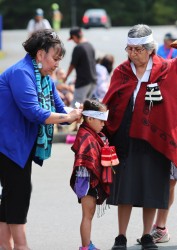Article Origin
Volume
Issue
Year
Four 15-foot totem poles are now at home at the entrance to the Saanich Peninsula Hospital telling all who enter the facility that this is the territory of the WSÁNEĆ First Nations communities and that the hospital is committed to culturally safe care.
An unveiling ceremony was held July 7. The poles were created from a log felled in Huu-ay-aht territory on West Coast of Vancouver Island and blessed there before it traveled to the East Coast of the Island, where carvers from each of the four WSÁNEĆ nations went to work. Master carvers and young apprentice carvers worked together on the project.
Organizers gave tokens to four witnesses as in appreciation
of their job to remember and talk about the event. Skip and May Sam and their great-granddaughter lit candles and May sang a hauntingly beautiful prayer song. She said it was a blessing for healing, a blessing for all the hard work that went into the poles. It was a blessing for each and every one in the
hospital, and a special prayer for the nurses and doctors that toiled there.
While the event was not part of the 39th annual Elders Gathering held at the nearby Panorama Centre in North Saanich, many from that event were bused to the hospital to witness the poles unveiling. Said carver Charles Elliott “to have our pole raising and unveiling ceremony during the time of the Elders Gathering makes it very special.” He said that before the
totems—“our silent ambassadors”—there wasn’t anything on the hospital site to indicate that it was on First Nations’ territory. He said the carvers put their hearts and souls into the project.
Carver James Jimmy thanked Elliott for being “a really great
teacher.” Carver Mark Henry said he was always amazed at how the Coast Salish people always come together. “I am very grateful for what is taking place.” He said he hoped the people gathered were filled with joy and happiness at what our carvers have brought out in their work.
Doug LaFortune, and his son Bear, carved the Tsawout pole.
He said it was a real pleasure to work with all the carvers. “To do a totem like this was a real honor” and became more so as he realized how important it was to the people in the community.
Chief Don Tom of the local Tsartlip Nation thanked the
Saanich Hospital’s nurse liaison Jane Fox for her dedication and commitment. He said she was modest and humble, but was the catalyst to make the work a team effort. She had asked, what would make the hospital a more welcoming place, and this was the answer to that question.
He said the welcome figures will help foster good relations.
“Where you nurture a good relationship, healing will happen that much faster.”
Western Forest Products was acknowledged for donating the log, as well as the partners that contributed to the project were thanked.
“We are grateful for the contributions from [First Nations
Health Authority]… the Saanich Peninsula Hospital Foundation, Peninsula Co-op, Island Health,” said Tsawout Chief Harvey Underwood. And he acknowledged the carvers “who expressed our people’s hearts and culture and identity of the land through carving.”
“This is reconciliation,” said Chief Vern Jacks of Tseycum
First Nations. He said to the non-Natives in the audience, “It’s about learning. You learn about us, and we learn about you.” He said everyone had the same color blood, just different color skin. The carvers, he said, “are good medicine.”
Chief Rebecca Harris of Pauquachin First Nation said the
poles gave a representation of the four communities in the stories that they tell.
Aboriginal Relations and Reconciliation Minister John Rustad
said “These cultural creations are symbolic of the shared commitment to culturally safe care for all.” He said the poles were fitting sentinels to stand watch over the entrance to the hospital.
“I know the work of these highly skilled and respected
Aboriginal artists will speak to all who enter here of the lasting culture, and presence of the WSÁNEĆ First Nation people.”
Lydia Hwitsum, board chair of the First Nations Health Authority, said the totems honor the ancestors and represent the peoples who have always been in this territory, and share a message of how we can work better together as neighbors and partners.
“They are also a way to honor and recognize the service
providers and caregivers, supporting them to reflect on cultural humility and how to best offer culturally safe services in a health care setting.”
- 1565 views

